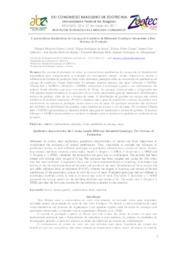Características qualitativas da carcaça de cordeiros de diferentes genótipos submetidos a dois sistemas de produção.
Características qualitativas da carcaça de cordeiros de diferentes genótipos submetidos a dois sistemas de produção.
Author(s): LOIOLA, P. M. G.; SOUSA, D. R. de; GOMES, D. P.; LINHARES, J. C.; BATISTA, A. S. B.; ALBUQUERQUE, F. H. M. A. R. de
Summary: Resumo: No sistema de produção de carne, as características qualitativas da carcaça são de fundamental importância para complementar a avaliação do desempenho animal. Assim, objetivou-se avaliar a influência do sistema de produção, bem como diferentes genótipos sobre as características qualitativas da carcaça de cordeiros. Foram observados 24 animais, machos inteiros, das raças ½Dorper x ½SPRD, ½Santa Inês x ½SPRD e ½Somalis x ½SPRD, submetidos à terminação a pasto e em confinamento. Os animais foram abatidos com peso vivo médio de 30 kg. As carcaças foram pesadas e refrigeradas por 24h, quando foram extraídos os Longissimus dorsi e neles mensurados grau de marmoreio, distribuição e textura da gordura, além da cor e textura da carne. A distribuição da gordura na carcaça não sofreu influência de nenhum tratamento (P>0,05), enquanto que o grau de marmoreio e textura da gordura teve interferência do sistema de produção, assim como a cor da carne. Os genótipos avaliados não diferiram nos atributos de distribuição da gordura, como também na textura e cor da carne. Os cordeiros ½Santa Inês x ½SPRD apresentaram as menores médias para grau de marmoreio e textura da gordura. O mestiço ½Dorper x ½SPRD proporcionou os melhores resultados para os parâmetros qualitativos avaliados nesta pesquisa. [Qualitative characteristics the Carcass Lambs Different Submitted Genotypes Two Systems of Production]. Abstract: In system meat production, qualitative characteristics of carcass are basic importance to complement the evaluation of animal performance. Thus, objectified to evaluate the influence of production system, as well different genotypes on qualitative characteristics carcass of lambs. Twenty four animals had been observed, entire males, breeds ½ Dorper x ½ SPRD, ½ Saint Ines x ½ SPRD and ½ Somalis x ½ SPRD, submitted the termination the grass and in confinement. The animals had been abated with average alive weight of 30 kg. The carcasses had been weighed and cooled for 24h, when they had been extracted Longissimus dorsi and in them measured degree of marbling, distribution and texture of the fat and texture beyond the color and texture of the meat. Distribution of fat in carcass did not suffer influence from no treatment (P>0.05), whereas the degree of marbling and texture of fat had interference of the production system, as well the color of meat. Evaluated genotypes had not differed in distribution attributes of fat, as well as in texture and color of meat. The lambs ½ Saint Ines x ½ SPRD presented the average minors for the marbling attributes and texture of fat. The mixed race ½ Dorper x ½ SPRD provided the best ones resulted for the attributes evaluated in this research.
Publication year: 2011
Types of publication: Paper in annals and proceedings
Unit: Embrapa Goats & Sheep
Keywords: Animal nutrition, Brasil, Brazil, Carcass quality, Confinamento, Confinement, Cordeiro, Genotype, Genótipo, Lambs, Nutrição animal, Ovino, Qualidade de carcaça, Sheep
Observation
Some of Embrapa's publications are published as ePub files. To read them, use or download one of the following free software options to your computer or mobile device. Android: Google Play Books; IOS: iBooks; Windows and Linux: Calibre.
Access other publications
Access the Agricultural Research Database (BDPA) to consult Embrapa's full library collection and records.
Visit Embrapa Bookstore to purchase books and other publications sold by Embrapa.

